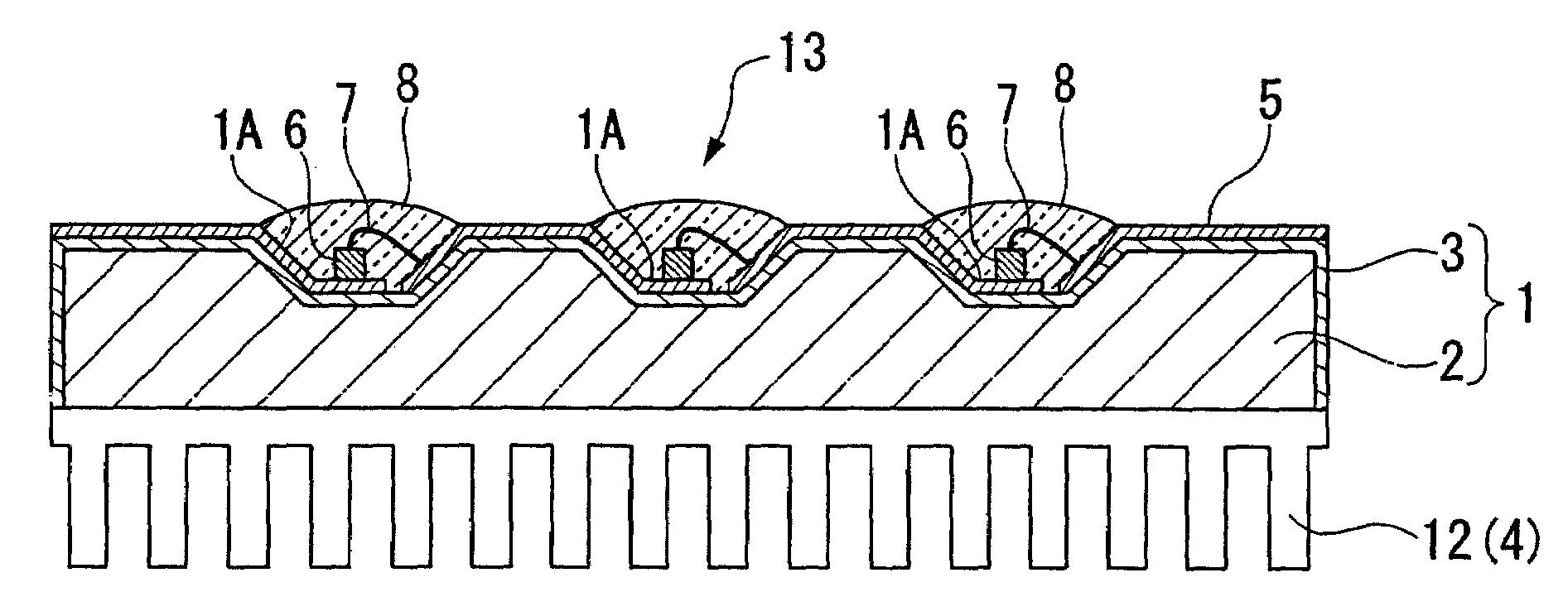Light-emitting element mounting board, light-emitting element module, lighting device, display device, and traffic signal equipment
a technology of light-emitting elements and mounting boards, which is applied in the direction of semiconductor devices for light sources, transportation and packaging, lighting and heating apparatus, etc., to achieve the effect of improving heat radiation, maintaining high light emission efficiency of light-emitting elements, and efficiently radiating heat emitted
- Summary
- Abstract
- Description
- Claims
- Application Information
AI Technical Summary
Benefits of technology
Problems solved by technology
Method used
Image
Examples
embodiments
[0086]As the core metal, a low-carbon steel sheet of 100 mm length, 30 mm width and 1.5 mm thickness was used, and the reflective cup portions were formed by drill machining. Seven reflective cup portions were formed in one row at intervals of 14 mm in the lengthwise direction of the core metal, and these were formed in two rows for a total of 14. As for the dimensions of the reflective cup portions, diameter was 2 mm and depth was 0.5 mm, while the sloped parts were made at a 45 degree angle.
[0087]Next, liquid in which glass powder was mixed in a dispersion medium and uniformly dispersed was applied to the surface of said core metal, and dried, after which baking was conducted at 850 degrees centigrade (° C.) to form the enamel layer. The thickness of the enamel layer was made to be 200 micrometers (μm), copper paste was applied to the electrode formation region of the face on which the reflective cup portions were formed, and baking was conducted to form electrodes of 0.1 mm thick...
working example 1
[0088]Sandblasting treatment was performed on the face of said enameled board where the reflective cup portions were not provided, the enamel layer was removed, and treatment was conducted to expose the core metal and form the heat radiating part, as shown in FIG. 1.
[0089]As the light-emitting elements, blue LED elements of 20 mW output were mounted in the reflective cup portions of this board. A total of 14 blue LED elements were mounted on said enameled board, and the reflective cup portions were sealed with silicon resin mixed with yellow light-emitting fluorescent powder, whereby white LEDs were made.
[0090]When drive current of 60 mA was made to flow into these LED elements to cause light emission, and when the central temperature of the board was measured, the temperature of the central part of the board was 130 degrees centigrade.
working example 2
[0091]Sandblasting treatment was performed on the face of said enameled board where the reflective cup portions were not provided, the enamel layer was removed, and treatment was conducted to expose the core metal. Next, face where the core metal was exposed was subjected to drill machining, holes with a diameter of 2 mm and depth of 0.2 mm were made, and a heat radiating part was formed as shown in FIG. 2 which was provided with a total of 30 indentations enlarging the surface area of the portion where the core metal was exposed.
[0092]As shown in FIG. 2, blue LED elements of 20 mW output were mounted in the reflective cup portions. A total of 14 LED elements were mounted on the enameled board, and the reflective cup portions were sealed with silicon resin mixed with yellow light-emitting fluorescent material, whereby a white LED module was made. When current of 60 mA was made to flow into each LED element to cause light emission, and when the central temperature of the board was me...
PUM
 Login to View More
Login to View More Abstract
Description
Claims
Application Information
 Login to View More
Login to View More - R&D
- Intellectual Property
- Life Sciences
- Materials
- Tech Scout
- Unparalleled Data Quality
- Higher Quality Content
- 60% Fewer Hallucinations
Browse by: Latest US Patents, China's latest patents, Technical Efficacy Thesaurus, Application Domain, Technology Topic, Popular Technical Reports.
© 2025 PatSnap. All rights reserved.Legal|Privacy policy|Modern Slavery Act Transparency Statement|Sitemap|About US| Contact US: help@patsnap.com



